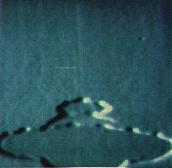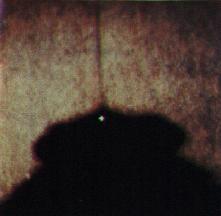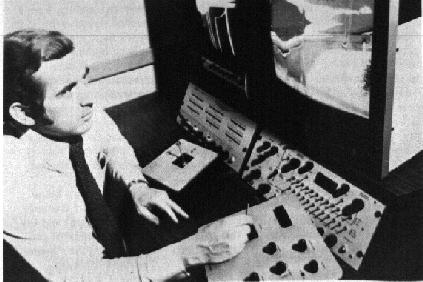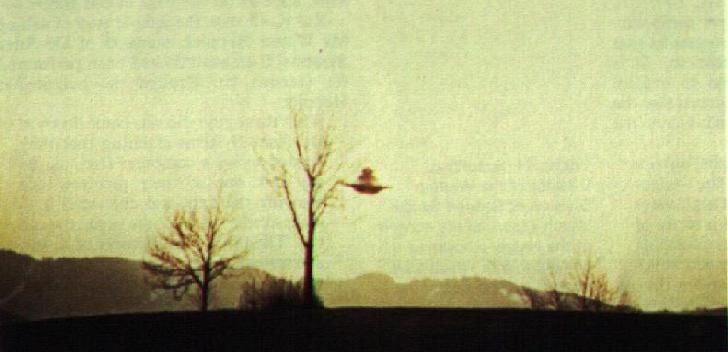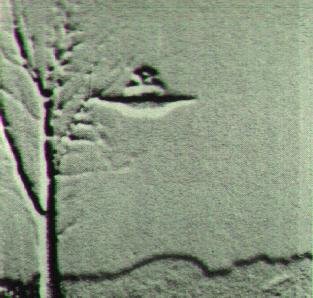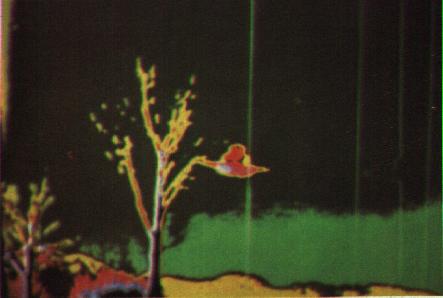The camera never lies?, Brookesmith, Peter, UFO updates mailing list, internet, January 1997
IMPORTANT NOTE
This article is not an official FIGU publication.
By Peter Brookesmith
Massive scientific expertise has vindicated Billy Meier's spacecraft photographs, according to his supporters. These claims however should be pitted against the rather different conclusions of skilled ufologists.*
THE PHOTOGRAPHS TAKEN by 'Billy' Meier of Pleiadean spacecraft as they flew around the valleys near Hinwel, Switzerland, are among the most striking UFO pictures ever published. They are so striking that they evoke that paradoxical response:_ too_ good to be true. But after a while one realises, looking at these elegant productions, that one's instinct has backed away from them for a less cynical reason: the pictures simply don't _fit_ with one's sense of light and shade as seen in the real world. They are visually disjointed, offending one's sense of balance, clashing with one's memory of how things look. Then, on a closer look, certain patterns in the pictures emerge - and certain suspicions are aroused.
The title image shows a Type-4 spacecraft over Mount Auruti, Switzerland, photographed by Billy Meier on 29 March 1976. Above, the two computer-enhanced images made from this photograph reveal a great deal about this picture. The left-hand image shows, in the words of Ground Saucer Watch who made the computer analyses, 'evidence of a linear structure above the craft - in plain english, a string or rod supporting the object. The structure is equally clear in the computerised enlargement in the second image. In addition,study of the focus in this picture indicates that the object is close to the camera and is therefore small - about 8 inches (20 centimetres) across, not 23 feet (7 metres) as claimed.
Is it coincidence, for example, that so many pictures of the same craft seem to show he flying disc at exactly the same angle to the camera, despite the very different locations and times of day at which the pictures were supposedly taken? Why do the reflections and shadows on the Pleiadean spaceships appear the same, too, despite the various backgrounds? Why are the undersides of the craft always so drak - as they would be if they were models, say, close to the camera? Why does only one picture, of extremely low quality, exist of a landed disc? Is there any significance in the massive preponderance of shots in which the craft are shown against a clear, light sky - the best type of background on which to superimpose a UFO image?
Wendelle Stevens and Genesis III - whom it seems fair to call both investigators and publicicts of the Meier case - have their own answers to some of these questions. In an interview with the ufologist Timothy Green Beckley, Wendelle Stevens rather disarmingly remarked:
First of all, photographs are poor evidence because there are so many things that we can do technically to produce images.However, there are also so many ways we can detect a hoax. We can tell if we are dealing with superimposed overlays, reflected images, double exposures. We can tell by looking through special microscopes and searching for grain density and grain patterns. We can pretty much tell if an object has been thrown into the air or suspended by something in the air.
And in keeping with that sceptisism, the book published by Genesis III, _UFO...Contact from the Pleiades,_ shows computer processed versions of the photographs that appear to validate their authenticity. It is when Wendelle Stevens starts to explain some of the computer enhancements that the reader's credulity is stretched. Says the colonel:
We can [analyse photographs] with a computer by studying the edges around any given object. In high magnification an edge is seen as a series of shock waves. There is a special formula for the spacing of these shock waves that make up the edge. How strong they are, how far apart they are, will tell you how far apart that edge of the object is from the camera. If the body is in motion, the shock waves are compressed on the leading edge and expand on the trailing edge.
In Fact, nothing of the kind happens. What this particular computer process does is enhance the picture contrast in areas where the image brightness varies - especially at the edges of features, making it possible to make judgements about how far the object is from the camera. In some cases, it is possible to intensify otherwise hard-to-detect strings or supports attached to the object. This has nothing to do whatever to do with shock waves, though Stevens has repeated the idea more than once.
William H. Spaulding, Director of the Western division of Ground Saucer Watch (GSW), at the console of the image-processing computer with which GSW analyse UFO photographs. GSW's verdict on the Meier pictures that they studied: 'Total hoaxes'.
In Genesis III's book, the 12 or so pictures purporting to show analytic enhancements of Meier's pictures are accompanied by detailsof the various tests to which the photographs were subjected. It is claimed that the computer enhancements showed how the light values of the landscape are consistent with those on the bottom of the craft. Supposedly, the test eliminates, double exposures or 'paste-ups' - splicing images from two different transparencies together. So far, perhaps, so good. The name of a reputable computer systems company, De Anza Systems, appears on the edeg of one frame.
Kal Korff took the simple step of asking Mr Wayne Heppler, manager of De Anza Systems, if an analysis had been performed for Genesis III. Replied the honest Mr Heppler:
What these guys did was come down to De Anza Systems claiming they wanted to _buy_ a computer from us. So we took one of their pictures, one showing the UFO, and enhanced it to make certain parts of the picture stand out. Then they took pictures of it, left, and stated they would get back in touch with us. And we haven't heard from them since.
Korff then asked if De Anza Systems had the technical capability to analyse the pictures. The answer: 'No. We are in no position to do an analysis.'
At a lecture at the UFO '80 symposium held in Oakland, California, in August 1980, Jim Dilettoso of Genesis III said that 'z-scale contouring' and 'edge identification' tests were run on the pictures. The only drawback to this is that these are simply colour contouring techniques (and can be used to analyse 'density' at each point of an image - its lightness or darkness). They are _not _light distortion tests, such as edge enhancement, which might reveal the information Genesis III claim to have gained by the techniques. Dilettoso also (perhaps rather rashly) took exception to a Ground Sauser Watch (GSW) colour contouring of one of the Meier pictures. This shows a similar level of light reflectivity on both the ground and the Pleiadean spacecraft - indicating that _something_ is wrong with the photograph, since the materials at the claimed distances, should reflect (and so colour contour) differently. Dilettoso's objection was unfortunate, since even Genesis III's computer-generated picture shows both the craft and its background in the same colour contour.
It did so, Kal Korff discovered, for reasons that could prove nothing about the authenticity of Billy Meier's photographs. According to Ken Dimwiddie, one of the technicians at De Anza Systems, who was present when Dilettoso appeared in the guise of a prospective customer, it was Dilettoso himself who assigned the colours on the computers read-out screen. In other words, the colours may indicate almost nothing about the actual qualities of the original photograph. They have little value except to satisfy Jim Dilettoso's aesthetic fancy.
This photograph was taken within a few minutes of the one at the top of the page. The craft is said to be hovering beyond the tree, which is about 165 feet (50 metres) away. Two computer-processed versions appear below. The edge enhancement on the left revealed, according to GSW, inconsistencies between the shadows on the disc and on the tree. This suggests that the UFO and landscape images have been superimposed. The colour-contoured image on the right suggested to GSW that the UFO image was actually superimposed _on top _of the tree image, as if the UFO were closer than the tree - 'indicating very sloppy work', in Kal Korff's words...
Computer-aided analyses of the Billy Meier pictures by Ground Saucer Watch, however are devastating by comparison. They inspired two GSW researchers, Fred Adrian and William Spaulding, to describe them as 'hoaxes, both crude and grandiose'.
Even without the aid of computer enhacement the photographs are dubious. Shadows on the Pleiadean craft do not conform to the light in the landscape, and the sharpness of the UFO images indicates that the object shown is extremely close to the camera - as a model would be. (GSW's estimate is that the various 'spaceships' are, in fact, between 8 and 12 inches [20 and 30 centimetres] in diameter.) Fuzziness that would result from atmospheric effects is often lacking.
Where the images are more consistent with expectations, one is still left baffled by the testimaony of Meier himself. Despite his constant contacts and the priceless photographic evidence he was gathering on behalf of mankind, Meier never bothered to repair or replace his allegedly broken camera, whose lens was stuck, focused at infinity. Yet different focusings _do_ seem to have been achieved - resulting in 'distant' objects coming out as suitably fuzzy.
But then this testimony concerning Meier and his photographis techniques occasionally leaves the disinterested enquirer gasping. It should be pointed out that Billy Meier lost his left arm in an accident, which one would expect to make for difficulties with a camera. Wendelle Stevens nevertheless has made the startling claim that Meier shot all his pictures from the hip, because the mirror in his camera had 'jammed closed' as well. And yet he manages to centre his UFOs in every frame with amazing precision.
Jim Dilettoso also says that a professional photographic expert claimed he would need 'a million dollars' to duplicate the Meier pictures. Less excitably, Wendelle Stevens attempts to debunk the claims that the UFOs are models by asking: 'How many models can a one-armed man carry on a moped when he is driving with the only arm he's got?' One might reply: 'As many as will fit in a bag.'
This picture from a scorched negative found in Meier's barn, was never intended to be published. It shows, unmistakably, a model spacecraft on a table-top. Meier admitted that he possessed models of the Pleiadean craft - made by his children from his descriptions, he insisted.
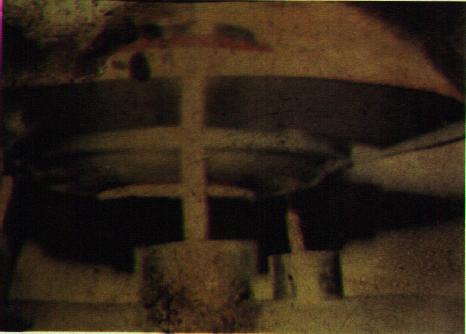
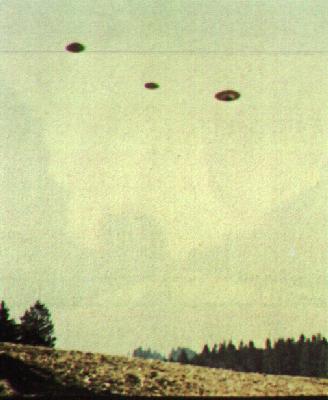 Meier Reported that these discs were photographed
Meier Reported that these discs were photographed
about 1-1/2 hours after the one at the top of the page.
GSW found that the focus on the discs is much sharper
than on the trees, showing that the discs are much
closer. Again, there is evidence that the UFO images
were superimposed on the landscape pictures.
So what is one to make of the Meier case? Certainly, the material evidence is anything but convincing, and the tales told by Meier have (as GSW have pointed out) all the hallmarks of American George Adamski's extravaganzas, updated and technically sophisticated for a more demanding age.
It is disheartening to learn that Stevens received an invitation to present his case to the House of Lords UFO Committee, who should have known better than to invite him in the first place.
Genesis III come out of the affair in greater embarrassment than Meier, who, after all, is apparently renowned for being 'a sort of person who gets great satisfaction out of fooling the authorities'. Genesis III have published some remarkable claims on behalf of Meier, yet none of those claims has been validated by independent research. Wendelle Stevens may attempt to disarm the ufologist Jim Lorenzen by saying, 'As you well know, Jim, the book was never designed to present any hard facts,' yet it gives every impression of doing just that.
As for Meier himself, it is possible that some _subjective _experience lies behind the discredited material evidence. If the stories of voices in the head, going for rides in'pear-shaped UFOs' with 'a very old man' at the age of five, and the sightings he had from a very early age are anything to go by, this may be the best explanation. In which case, the model spacecraft (whose existence Meier doesn't deny) may well have been constructed as a result of an actual series of contactee experiences, however unlikely it is that these represent an attempt by any Pleiadeans to get in touch with us on Earth. If so, then Billy Meier has unfortunately allowed his experience to be turned by others into something like an industry.

